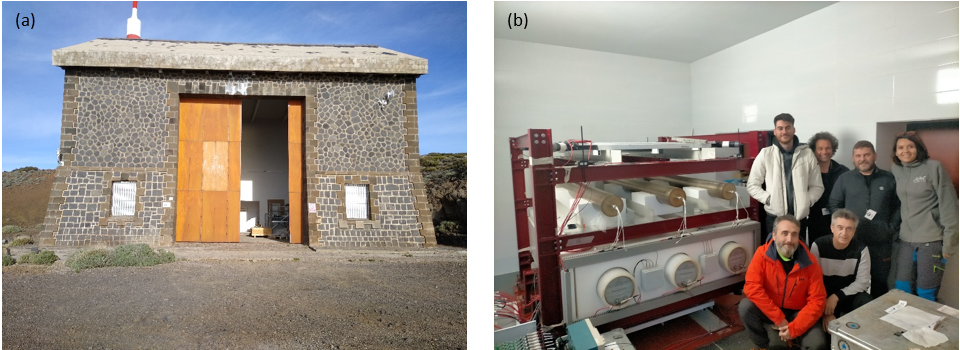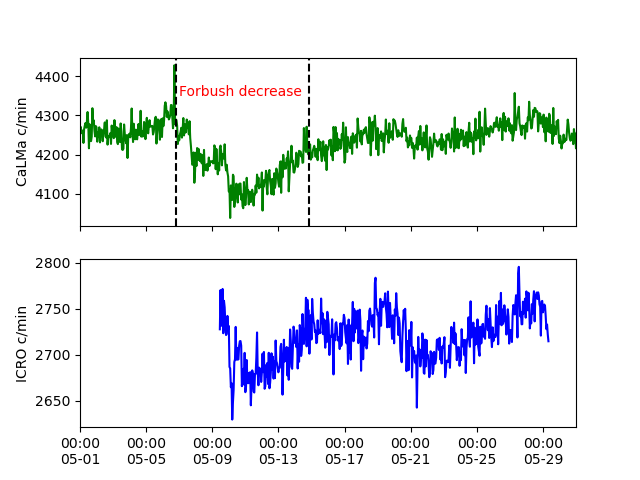Creation of the New Cosmic Rays Observatory in Izaña (ICaRO)
Clic here for spanish version
The ICaRO Cosmic Rays Observatory has been installed at the Izaña Atmospheric Observatory. Cosmic rays are highly energetic particles that originate from outer space and constantly penetrate interplanetary space and the Earth’s atmosphere. Fortunately for life on Earth, not all cosmic rays reach the Earth’s surface; the magnetosphere and the Earth’s atmosphere act as a natural protective layer against them. Magnetic rigidity is the physical magnitude that determines the threshold at which a cosmic ray can produce secondary particles that may reach the Earth’s surface. In turn, the minimum magnetic rigidity that a charged particle must have in order to penetrate the magnetosphere and the Earth’s atmosphere, and produce particles capable of reaching Earth’s surface from outer space, is known as the vertical rigidity threshold.
In particular, due to its geographical location and altitude of 2373 meters above sea level, the Izaña Atmospheric Observatory has a calculated vertical rigidity threshold of 11.5 GV. This means that only those particles exceeding this rigidity level will be able to reach the new detector.
ICaRO is the second of its kind to be installed in Spain; the first one is located at the Spanish Antarctic Base Juan Carlos I. It is dedicated to observing secondary cosmic rays, particularly neutrons and muons, and in the case of the latter, also their direction of incidence.
Currently, there is an organization that collects data from these types of detectors, the Global Neutron Monitor Network (https://www.nmdb.eu), or NMDB for short. Having measurements from different stations with distinct vertical cutoff rigidities is a powerful tool for various scientific investigations. ICaRO’s elevation above sea level and cutoff rigidity position it as an exceptional detector, filling a gap in the NMDB. Moreover, it enables the observation of neutrons generated during highly energetic solar events, facilitates solar activity monitoring, and enables the study of interactions between cosmic rays and solar energetic particles within the atmosphere.
ICaRO was installed in IZO in late February 2023, made possible through collaborative efforts between the University of Alcalá and the Izaña Atmospheric Research Center (IARC), operating under the State Meteorological Agency (AEMET).

Figure 1. (a) ICaRO’s Location at IZO, in the Comet Hangar, and (b) ICaRO Installation with the University of Alcalá and AEMET Team.
While ICaRO is still in the process of being commissioned, it has been consistently generating stable data since its installation. Figure 2 shows a solar event recorded by the reference instrument CaLMA (Castilla-La Mancha Neutron Monitor). This is a Forbush decrease, named after the American physicist Scott E. Forbush, who pioneered the study of the relationship between solar disturbances and variations in cosmic ray intensity in the 1930s. These Forbush decreases specifically refer to the temporary reduction in the amount of cosmic rays reaching the Earth due to interferences caused by solar activity.
This event, which occurred in early May 2023, was captured by ICaRO during the final stage (decreasing phase) and throughout the entire recovery phase.

Figure 2: Forbush Decrease observed by CaLMa in early May (top panel). The lack of data in early May was due to an issue in the acquisition system, although this did not prevent the partial observation by ICaRO.
Once its implementation is complete, this observatory will provide the unique capability to observe both galactic neutrons and muons as well as those emerging during solar events, enabling continuous monitoring of solar activity. Moreover, it enables the investigation of the intricate interactions between cosmic rays and energetic particles originating from the Sun within the atmospheric environment. These investigations yield significant insights in the context of space weather and its ramifications.







